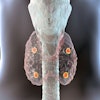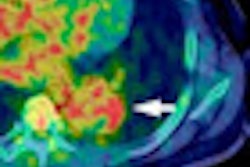ATLANTIC CITY, NJ - Contrast-enhanced ultrasound (CEUS) offers much potential for molecular imaging applications such as in vivo imaging of angiogenesis and assessing disease states for therapy monitoring. Researchers described the state of the art in CEUS in a presentation this week at the Leading Edge in Diagnostic Ultrasound conference.
To facilitate the development of this nascent technology, work is under way to address technical hurdles affecting its sensitivity, specificity, field-of-view, and quantitative capabilities, according to a presentation by Paul Dayton, Ph.D., an associate professor of the joint department of biomedical engineering of the University of North Carolina and North Carolina State University.
"I'm hoping it won't be too long in the future that we can see images where we have volumetric information, where we can look at several different molecular targets based on different-sized contrast agents, and, ideally, we would have some idea of about how many cells are expressing these molecular targets," he said.
In contrast to traditional ultrasound viewing of anatomical features or blood flow, molecular imaging requires imaging of cellular and molecular changes. The goal is to gain enhanced detection of pathologies that are not easily detectable with traditional ultrasound or to monitor therapy by assessing disease states, Dayton said.
As an inexpensive, portable, real-time, and safe imaging method, ultrasound offers a lot of advantages in molecular imaging over other modalities, he said. "It makes sense to turn ultrasound imaging into a molecular micro-imaging tool."
Ultrasound molecular imaging takes into account knowledge of the molecular signature of pathology, utilizing targeted contrast agents that incorporate adhesion ligands (such as an antibody or a peptide on the microbubble shell) or other selective mechanisms that will adhere to the diseased cell, Dayton said. These agents are injected intravascularly and then collect at the site of pathology.
This allows for tasks such as in vivo angiogenesis imaging and molecular imaging of therapeutic response.
Challenges
Molecular imaging with ultrasound requires sensitivity -- the ability to detect small numbers of targeted contrast agents that are attached to disease cells. It also must have specificity, to detect only the target area and not be confounded by freely circulating contrast agent that hasn't bound to the target, he said.
It must also have a field-of-view that allows for interrogation of the entire disease area, and it would ideally have a quantitative ability that allows for correlation of image contrast with degree of pathology, Dayton said.
Currently available contrast agents, however, have a mean diameter and polydispersity (i.e., variations in size) that don't fit as well with the requirements of molecular imaging, according to Dayton. Today's contrast agents have a mean microbubble size distribution of 1.8 ± 1.5 microns in diameter.
Different-sized microbubbles react differently to ultrasound signals based on their size. In a recent acoustic experiment involving microbubbles of uniform size, researchers noticed, among other findings, that the larger the microbubble size, the higher its acoustic response.
"So there are definitely ways to optimize the response that we see from microbubbles," he said. "And, quite frankly, most of the commercial microbubbles are not optimized for detection with commercial imaging systems. To date this really hasn't been a problem, because with [traditional] contrast imaging you inject millions to billions of these contrast agents into a patient and you only needed to detect a small fraction of those. So it's not important that you're really sensitive to every single microbubble."
That's not the case with molecular imaging, which requires optimized sensitivity for the small number of microbubbles that are retained in the tissue, he said.
A previous study evaluating kidney perfusion in a rat found that a contrast agent with an optimal size for molecular imaging led to a 10- to 15-fold increase in sensitivity compared to a low dose of a standard contrast agent.
"This is something that we're going to see in the not-too-distant future," he said. "Microbubble diameter and distribution can substantially improve imaging sensitivity, and I'm sure it won't be long until the microbubble manufacturers will be moving in this direction."
As for specificity, one way to improve it is to make better adhesion ligands for the microbubbles. In addition, improved rejection of nontargeted contrast agents could help. An ultrasound molecular imaging signal processing technique would enable real-time detection of microbubbles.
This can be achieved using filtering techniques, separating freely circulating agents from agents bound to pathology, he said.
"This is what needs to happen to make molecular imaging a real-time technique in the clinic," he said. "Prior commercial imaging systems are not really optimized to do this yet, but the technology is possible, and I'm sure as we find molecular imaging becomes more of an interest to clinicians, this is something that we'll see available on clinical imaging systems."
Field-of-view also represents a challenge for ultrasound molecular imaging. Single-slice imaging may not provide reliable information in nonhomogeneous tissue. In addition, while 3D contrast imaging will provide essential data about the distribution of molecular targets in tissue, high-resolution, contrast-specific 3D tissue imaging is just starting to be developed, he said.
Quantitative ability represents yet another challenge. Right now, most molecular imaging is based on relative measurements, mostly generated from image video intensity.
"Ideally, we would want to know the exact relation between video intensity and the number of microbubbles that are retained in the tissue, so we can more quantitatively assess disease states," he said. This task has been difficult, due in part to the polydisperse nature of current microbubbles.
"Development of uniformly sized contrast agents in the future may allow the creation of algorithms to estimate the number of contrast agents retained in the acoustic intensity," he said.
By Erik L. Ridley
AuntMinnie.com staff writer
May 14, 2010
Related Reading
Trials aim to bring radiology ultrasound contrast to U.S., May 13, 2010
New CEUS technique images angiogenesis, March 1, 2010
Interest grows in noncardiac ultrasound contrast applications, May 21, 2009
CEUS of focal liver lesions in the noncirrhotic liver, May 19, 2009
Bracco revisits plans for U.S. launch of SonoVue, March 8, 2009
Copyright © 2010 AuntMinnie.com





















